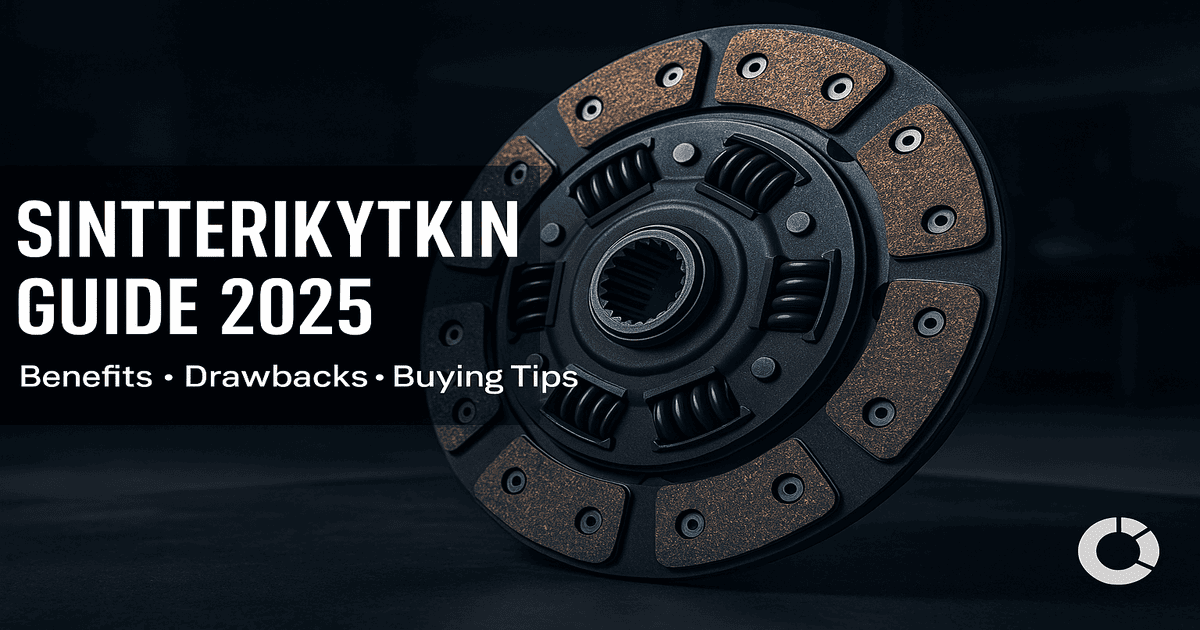Introduction
When upgrading a performance car, many enthusiasts focus on adding horsepower, bigger turbos, or custom exhausts. Yet one critical component often gets overlooked: the clutch. As the vital link between the engine and transmission, the clutch determines how effectively power reaches the wheels. Without the right clutch, even the most powerful engine cannot deliver its full potential.
This is where the sintterikytkin—the Finnish term for “sintered clutch”—comes in. Built with high-performance materials designed to withstand heat and stress, the sintterikytkin is trusted in motorsport and heavy-duty applications where standard clutches fail. But while it shines on the track, it is not the best choice for every driver.
In this guide, we’ll explore what makes the sintterikytkin unique, how it works, its advantages and trade-offs, how it compares to other clutches, and what to consider before upgrading. By the end, you’ll know if this specialist clutch belongs in your build.
What Is a Sintterikytkin?
A sintterikytkin differs from a conventional clutch primarily in its friction material. Standard clutches typically use organic linings reinforced with fibers. These offer smooth, predictable engagement and work well for daily driving, but they wear quickly when exposed to heat and heavy loads.
The sintterikytkin, by contrast, uses sintered metal pads, often made from bronze or ceramic-metallic compounds. Sintering involves compressing powdered metal under pressure and then heating it until it fuses into a durable solid. The resulting clutch surface is far more heat-resistant and capable of transmitting greater torque than an organic clutch.
This makes the sintterikytkin a natural choice in motorsport disciplines like rally, drifting, and drag racing, where clutches are pushed to their limits under high torque and extreme heat.
How It Works
Like any clutch, a sintterikytkin connects and disconnects the engine from the transmission. The difference lies in how it engages. Instead of the smooth, gradual bite of an organic clutch, the sintered pads grip abruptly. Drivers often describe it as feeling like an “on/off switch.” While this makes stop-and-go traffic uncomfortable, it ensures quick, decisive engagement under racing conditions.
The sintered surface also resists glazing and slipping when hot. An organic clutch may start fading after a few aggressive launches, but a sintterikytkin maintains its bite even after repeated hard use. This consistency is a key reason racers rely on it.
Advantages of a Sintterikytkin
The main benefit of a sintterikytkin is its ability to handle extreme conditions. It resists overheating and maintains grip even when subjected to sustained abuse on track. This makes it ideal for turbocharged, supercharged, or heavily modified engines producing well above stock torque levels.
Another advantage is longevity under stress. While an organic clutch may fail quickly when pushed hard, a sintterikytkin can endure repeated launches and aggressive shifts without losing effectiveness. For serious drivers, this reliability provides peace of mind.
Ultimately, the sintterikytkin ensures that performance upgrades to the engine translate into real-world power at the wheels. Without a clutch that can keep up, the rest of the build is compromised.
Drawbacks and Limitations
Despite its strengths, the sintterikytkin has notable downsides. The most obvious is drivability. Engagement is abrupt, which can make smooth starts difficult and traffic driving tiring. For this reason, many enthusiasts avoid using sintered clutches in daily-driven cars.
The added stress on driveline components is another factor. Because the clutch grabs so firmly, gearboxes, driveshafts, and differentials may experience more wear if the setup is not properly matched. This does not make the sintterikytkin unsafe, but it requires careful consideration of the entire drivetrain.
Finally, sintterikytkin systems generally cost more than organic or ceramic options. While the investment makes sense for high-performance applications, casual drivers may not see enough benefit to justify the price.
Comparing Clutch Types
To put the sintterikytkin in context, let’s compare it to organic and ceramic clutches.
- Organic clutches are smooth, affordable, and excellent for daily driving. Their downside is poor heat resistance and limited torque capacity.
- Ceramic clutches offer a compromise. They handle more torque and heat than organic units while remaining somewhat manageable for street use.
- Sintterikytkin clutches stand at the top in terms of durability and performance, but their harsh engagement makes them impractical for most commuters.
This comparison shows why the sintterikytkin is best suited to dedicated performance cars, not everyday vehicles.
Choosing the Right Sintterikytkin
If you decide a sintterikytkin is right for your build, choosing the correct model is essential. The clutch must match your engine’s power and torque output. Using one that is underrated risks failure, while overspecifying may make the car unnecessarily difficult to drive.
Driving style also matters. A car built for drifting or drag racing may require a multi-puck design optimized for hard launches, whereas a track car might prioritize heat resistance and consistent performance over outright aggressiveness.
Compatibility is critical. Always confirm that the clutch fits your gearbox and flywheel before purchase. Reputable manufacturers such as Sachs, ACT, and Exedy provide detailed fitment guides and are trusted in motorsport for their reliability.
Installation and Care
Installing a sintterikytkin is not a simple DIY project. Because of the precision required, professional installation is strongly recommended. Misalignment or improper setup can cause premature wear or damage to the gearbox.
Some sintered clutches also require a break-in period, during which the surfaces bed in under light use. Skipping this step can shorten the clutch’s lifespan.
Maintenance is straightforward but important. Regular checks of the clutch and flywheel condition, along with mindful driving habits, help extend service life. Avoid excessive slipping, especially in traffic or on hills, as this accelerates wear. With proper care, a sintterikytkin can last significantly longer than organic alternatives under heavy use.
Cost and Value
Sintterikytkin systems vary widely in price. Entry-level kits start at around €400–€700, suitable for lightly modified cars. Mid-range kits, designed for engines producing 400–600 horsepower, often range from €800–€1,200. Motorsport-grade systems can exceed €1,500 and sometimes reach €3,000 or more.
While the upfront cost is high, the long-term value is clear for competitive drivers. A failed clutch during a race can cost far more in lost results and repairs than the initial investment in a sintered system. For serious builds, it is an expense that pays for itself in reliability.
Common Questions
Can a sintterikytkin be used for daily driving?
Yes, but it is uncomfortable for city traffic due to harsh engagement. It is designed for performance, not convenience.
Does it increase horsepower?
No. A clutch does not add power. Its job is to ensure your engine’s output is transferred effectively to the wheels without slipping.
How long does it last?
With proper use, a sintterikytkin can outlast organic clutches under stress. Lifespan depends heavily on driving style and correct installation.
Does it damage the gearbox?
It can increase strain on the drivetrain if mismatched or abused. With proper setup and responsible use, it should not cause damage.
Conclusion
The sintterikytkin is a purpose-built solution for high-performance applications. It thrives in motorsport and extreme builds where ordinary clutches fail, offering exceptional heat resistance, torque capacity, and reliability.
However, it comes with trade-offs. The harsh engagement, higher cost, and potential drivetrain stress make it unsuitable for most daily drivers. Instead, it should be seen as an investment for those who truly need its capabilities—racers, track-day enthusiasts, and builders of high-power cars.
If you fall into that category, a sintterikytkin is one of the most reliable upgrades you can make. Installed correctly and cared for properly, it provides the confidence and durability required to push your car to its limits without compromise.




